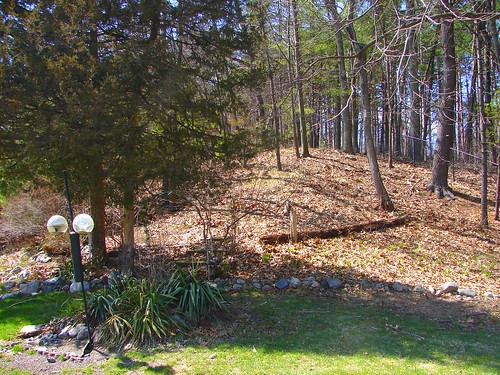Do you see anything odd about this picture?

The trees on the side of the hill are tilted. This is an example of a process known as "Downhill Creep" or just "Creep."

SOIL CREEP

The trees on the side of the hill are tilted. This is an example of a process known as "Downhill Creep" or just "Creep."

SOIL CREEP
"Soil Creep is just a slow adjustment of soil and rocks that is so hard to notice unless you can see the effects of the movement. These effects would be things like fenceposts shifted out of alignment, or telephone poles tipping downslope.
Another effect is the way a grass covered slope seems to ooze downhill forming little bulges in the soil. This heaving of the soil occurs in regions subjected to freeze-thaw conditions. The freeze lifts particles of soil and rocks and when there is a thaw, the particles are set back down, but not in the same place as before.
Gravity always causes the rocks and soil to settle just a little farther downslope than where they started from. This is the slow movement that defines creep. Creep can also be seen in areas that experience a constant alternation of wetting and drying periods which work in the same way as the freeze/thaw. Monitoring is essentially done through observation of the effects of creep. Since the process is so slow, it can only be monitored in terms of flow over long periods of time."
Another effect is the way a grass covered slope seems to ooze downhill forming little bulges in the soil. This heaving of the soil occurs in regions subjected to freeze-thaw conditions. The freeze lifts particles of soil and rocks and when there is a thaw, the particles are set back down, but not in the same place as before.
Gravity always causes the rocks and soil to settle just a little farther downslope than where they started from. This is the slow movement that defines creep. Creep can also be seen in areas that experience a constant alternation of wetting and drying periods which work in the same way as the freeze/thaw. Monitoring is essentially done through observation of the effects of creep. Since the process is so slow, it can only be monitored in terms of flow over long periods of time."
http://earthsci.org/processes/geopro/massmov/massmov.html

This hill is a lot bigger and a lot steeper than it looks! The slope is well in excess of 15% in both direction, so it qualifies as a steep hill. According the the Framingham Conservation Committee Master Plan Draft, "The development costs associated with construction on steep slopes are extremely high. Necessary expenses in order to develop these sloped include grading, retaining wall and vegetation in order to reduce run-off, erosion, lateral creep, or frost heaving. Consequently, these areas would be best left as undeveloped open space or conservation land."
Framingham Conservation Committee Master Plan Draft

The side of the hill that faces east has a 15% to 20% slope.

The south face of the hill leads directly to the house, and has a slope that exceeds 25%.
Creep is a normal process that affects every sloped surface. The amount of creep is affected by other factors besides the pitch of the grade. Excessive water, especially if the soil contains a large amount of clay, makes the slippery and more inclined to creep.

In some parts of the country they have something called "expansive clay soils". The clay expands when wet and contracts when dry. The expansion/contraction action exacerbates the creep process just as the freeze/thaw cycle described above. Despite the fact that Massachusetts is not affected by expansive clay soil according to the above map, the soil sample I dug up a few weeks ago definitely contracted when it dried.
Vegetation helps to stabilize the soils if present. The roots of plants, shrubs, and trees not only hold the soil in place, they also absorb excess moisture. In general, a slope without vegetation tends to move more than a slope with vegetation. There are exceptions to this rule, however. The weight of trees, plants, and bushes can also make soil heavier and more susceptible to gravity. This is especially true for slippery soils on bedrock.


the last picture is taken where (approximately) ?
ReplyDeleteThis is downhill (obviously!)from the Hultman aqueduct between Grove and Edgell.
ReplyDelete